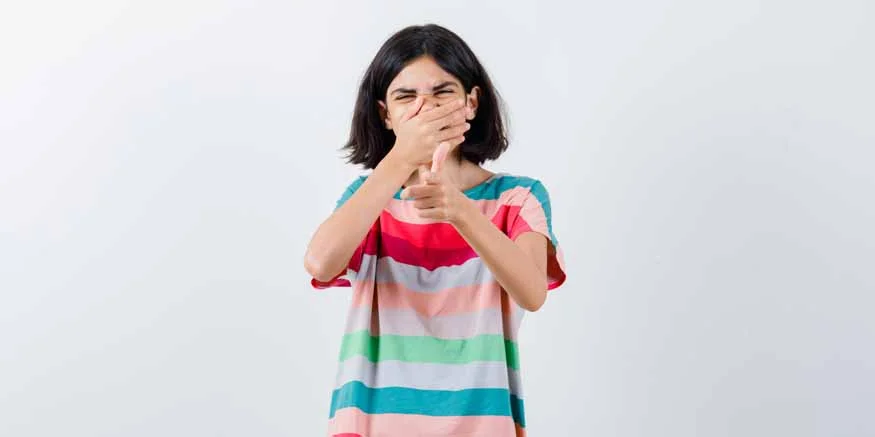Breathing through your mouth instead of your nose can make kids feel not so good and cause some health problems. But don’t worry, there are ways to help! This big guide will tell parents all about why kids breathe through their mouths and how to make it better so they can be healthy and strong. Let’s learn together!
Understanding Mouth Breathing in Children
Sometimes, kids breathe through their mouth instead of their nose a lot. It can happen during the day or when they’re sleeping. There are different reasons why this happens, like when their nose feels all stuffy, or when their tonsils or adenoids are bigger than they should be, or even if they have allergies. Knowing why it happens is the first step to helping them breathe better.
Also Read: What Happens If Kids Don’t Brush Their Teeth?
Identifying the Causes of Mouth Breathing
There are several potential causes of mouth breathing in children:
- Nasal Congestion: Often due to colds, sinus infections, or allergies.
- Enlarged Tonsils or Adenoids: These can block the airway, making it difficult for a child to breathe through their nose.
- Allergies: Allergic reactions can cause nasal congestion and make nasal breathing difficult.
- Structural Abnormalities: Deviated septum or other nasal obstructions can force a child to breathe through their mouth.
By identifying and addressing these causes, parents can take the necessary steps to stop mouth breathing in their children.
Effects of Mouth Breathing on Children’s Health
Mouth breathing can lead to a range of health issues:
– Dry Mouth: This can cause bad breath and increase the risk of tooth decay and gum disease.
– Sleep Apnea: Mouth breathing is associated with sleep-disordered breathing, including obstructive sleep apnea.
– Facial Growth: Chronic mouth breathing can affect the development of facial structures, leading to long-term changes in facial appearance.
– Reduced Oxygen Intake: Breathing through the mouth doesn’t filter air as effectively as nasal breathing, potentially reducing oxygen intake.
Recognizing these effects underscores the importance of addressing how to fix mouth breathing in children promptly.
Also Read: What Is Torticollis In Babies?
Effective Strategies to Stop Mouth Breathing
- Encourage Nasal Breathing
- Address Nasal Congestion
- Manage Enlarged Tonsils and Adenoids
- Create a Healthy Sleep Environment
- Regular Dental Check-ups
- Addressing Behavioral Factors
- Improve Air Quality
- Promote a Healthy Diet
Promote Nose Breathing: Okay, so first, let’s play a game with breathing! We’re going to practice using our noses to breathe during the day. That means keeping our lips closed and breathing through our nose like sniffing flowers! Every time you remember to breathe through your nose, we’ll give you a big high-five or a thumbs-up! It’s like collecting stars for being a nose-breathing champion! Keep it up, and soon it will be a super cool habit!
Breathing Exercises: First, take a big sniff through your nose like you’re smelling a flower, and count to four in your head. Then, hold your breath for another count of four, like you’re waiting for a surprise. Finally, let it out slowly through your nose, like you’re blowing out birthday candles. Let’s do it together a few times every day, and it’ll help make your nose stronger!
By always using your nose to breathe, you can help make your breathing even better and healthier. So, remember to keep those nostrils busy and breathe in through your nose like a champ!
Treat Allergies:If your nose feels all stuffy because of allergies, it’s best to talk to a special doctor called a pediatrician or an allergist. They know all about helping noses feel better! They might say you need some special medicine called antihistamines or nasal sprays to make the stuffiness go away. They’re like magic potions that help you breathe better and feel comfy again!
Saline Nasal Rinses: Did you know that using a special nose wash called saline nasal rinse can help you breathe better? It’s like giving your nose a little shower to wash away all the yucky stuff and make it feel better. It’s super helpful before bedtime so you can sleep well and breathe easily all night long!
By effectively managing nasal congestion, you can make it easier for your child to breathe through their nose.
Medical Evaluation: If your breathing feels funny because your tonsils or adenoids are big, ask a special doctor called an ENT to check. They can say if you need an operation like taking out your tonsils or adenoids.
Monitor Symptoms: If you snore a lot, or your ears hurt often, or it’s hard to swallow, you might have big tonsils or adenoids. Keep an eye on these things!
If you fix stuff that’s blocking your nose, it can help you breathe better through it.
Proper Sleep Position: It’s good if you sleep on your side instead of your back. When you sleep on your back, it can make you breathe through your mouth more and sometimes make it hard to breathe right. Also, if your bed is a little bit higher where your head goes, it can help too!
Humidifiers: Put a humidifier in your kid’s room to make the air all nice and wet. This stops their mouth and nose from getting all dry, so they can breathe through their nose and feel comfy.
A cozy bedroom helps you breathe better when you’re sleeping.
Dental Evaluation: Going to the dentist a lot can help find and fix things that make you breathe with your mouth, like crooked teeth or a bite that’s not right.
Oral Appliances: Sometimes, the dentist gives you special mouth stuff to help your jaw be straight and to help you breathe through your nose.
Going to the dentist is really important to help you breathe through your nose and not your mouth.
Habitual Training: If you breathe with your mouth a lot, you might need some help to stop. Try to remember to close your mouth and breathe through your nose instead. Little reminders from grown-ups and practicing all the time can make it easier to stop.
Therapy: Sometimes, a speech helper or a myofunctional helper can show you fun exercises and tricks to help you breathe better and keep your mouth in the right place.
If you keep breathing with your mouth open a lot, there are some things grown-ups can do to help you learn to breathe through your nose instead.
Reduce Allergens: Keep your house clean so you don’t get all sneezy! Vacuum a lot, use those machines that make the air nice, and don’t open the windows when there’s lots of pollen outside.
Ventilation: Make sure you open windows and let fresh air in your house so the air inside isn’t yucky and you can breathe better.
If we keep everything super clean and don’t let yucky stuff that makes us sneeze get in, our noses won’t get stuffy and we can breathe with our mouths closed!
Balanced Nutrition: Make sure your kid eats lots of yummy foods that help them stay healthy and breathe better. Give them fruits and veggies with vitamin C, like oranges and broccoli, and foods with zinc, like beans and nuts.
Hydration: Encourage your kid to drink lots of water! It helps keep everything inside their nose healthy and makes it easier to breathe. Water is super important!
Also Read: Tips For Administering Medicine To Your Toddler
Eating good food helps you stay healthy and can stop you from breathing through your mouth.
Visit EuroSchool to learn more about how we can support your child









